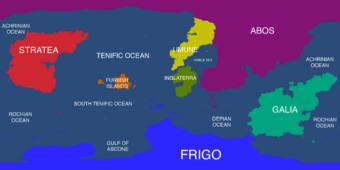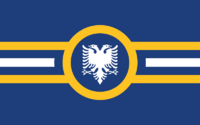Depian Ocean: Difference between revisions
mNo edit summary |
No edit summary |
||
| Line 32: | Line 32: | ||
==Water Characteristics== | ==Water Characteristics== | ||
==Climate== | ==Climate== | ||
Several features make the climate of the Depian Ocean unique. It constitutes the core of the large-scale ''"Tropical Warm Pool"'' which, when interacting with the atmosphere, affects the climate both regionally and globally. [[Abos]] largely blocks heat export preventing the ventilation of the Depian Ocean thermocline. The heat maintained by Abos also drives the Depian Ocean {{wp|monsoon}}, the strongest on Earth, which causes large-scale seasonal variations in ocean currents. The climate north of the equator is affected by a monsoon climate. Strong north-east winds blow from October until April; from May until October south and west winds prevail. In the [[Sea of Aegaeon|Aegaean Sea]], the violent Monsoon brings rain to the continent. When the monsoon winds change, {{wp|cyclone}}s sometimes strike the shores of the Aegaean Sea. In the southern hemisphere, the winds are generally milder, but summer storms near [[Tesyky]] can be severe. | |||
==Geology and Plate Tectonics== | ==Geology and Plate Tectonics== | ||
== | ==Marine Life== | ||
== | {{Multiple image | total_width = 600 | ||
| image1 = CSIRO ScienceImage 3012 Dolphin.jpg | |||
| image2 = Maldives Surgeonfish, Acanthurus leucosternon.jpg | |||
| image3 = Vagues et manchots à l'assaut de la plage.jpg | |||
| footer = A {{wp|dolphin}} off Western Galia and a swarm of {{wp|Acanthurus leucosternon|surgeonfish}} near the Attancian Islands represents the well-known, exotic fauna of the warmer parts of the Depian Ocean. {{wp|King Peguins}} on a beach near Frigo attract fewer tourists. | |||
}} | |||
Among the tropical oceans, the western Depian Ocean hosts one of the largest concentration of {{wp|phytoplankton}} blooms in summer, due to the strong {{wp|monsoon}} winds. The monsoonal wind forcing leads to a strong coastal and open ocean {{wp|upwelling}}, which introduces nutrients into the upper zones where sufficient light is available for photosynthesis and phytoplankton production. These phytoplankton blooms support the marine ecosystem, as the base of the marine food web, and eventually the larger fish species. The Depian Ocean accounts for the second largest share of the most economically valuable {{wp|tuna}} catch. It's fish are of great and growing importance to the bordering countries for domestic consumption and export. Fishing fleets from [[Attancia]], [[Greysonian Empire]], [[Huvakia]], [[Nordhagen]],and [[Tesyky]] also exploit the Depian Ocean, mainly for shrimp and tuna. | |||
{{Multiple image | total_width = 400 | |||
| image1 = Padadita Beach, Waingapu 18.jpg | |||
| image2 = Coelacanth1.JPG | |||
| footer = Left: Mangroves (here in East Nordhagen) are the only tropical to subtropical forests adapted for a coastal environment. From their origin on the coasts of the Depo-Galian region they have reached a global distribution.<br />Right: The coelacanth (here a model from Oxford), thought extinct for million years, was rediscovered in the 20th century. The Depian Sea species is blue whereas the Aegaean species is brown. | |||
}} | |||
80% of the Depian Ocean is open ocean and includes nine {{wp|large marine ecosystems}}, Coral reefs cover c. 200,000 km2 (77,000 sq mi). Coral reefs, sea grass beds, and mangrove forests are the most productive ecosystems of the Indian Ocean — coastal areas produce 20 tones per square kilometre of fish. These areas, however, are also being urbanised with populations often exceeding several thousand people per square kilometre and fishing techniques become more effective and often destructive beyond sustainable levels while increase in sea surface temperature spreads coral bleaching. | |||
{{wp|Mangroves}} cover 80,984 km2 (31,268 sq mi) in the Depian Ocean region, or almost half of world's mangrove habitat, of which 42,500 km2 (16,400 sq mi) is located [[Nordhagen]], or 50% of mangroves in the Depian Ocean. | |||
==Trade== | |||
The sea lanes in the Depian Ocean are considered among the most strategically important in the world with more than 80 percent of the world's seaborne trade in oil transiting through the Depian Ocean and its vital chokepoints. The Depian Ocean provides major sea routes connecting the [[Abos]], [[Gallia]], [[Inglaterra]] and [[Frigo]]. It carries a particularly heavy traffic of petroleum and petroleum products from the oil fields of bordering nations such as [[Huvakia]] or [[West Phoenicia]] Large reserves of hydrocarbons are being tapped in the offshore areas. An estimated 40% of the world's offshore oil production comes from the Depian Ocean. Beach sands rich in heavy minerals, and offshore placer deposits are actively exploited by bordering countries. | |||
==Environmental Issues== | ==Environmental Issues== | ||
Research indicates that increasing ocean temperatures are taking a toll on the marine ecosystem. A study on the phytoplankton changes in the Depian Ocean indicates a decline of up to 20% in the marine plankton in the Depian Ocean, during the past six decades. The tuna catch rates have also declined 50–90% during the past half century, mostly due to increased industrial fisheries, with the ocean warming adding further stress to the fish species. | |||
A Depian Ocean garbage patch was discovered in 2010 covering at least 5 million square kilometres (1.9 million square miles). Riding the southern Ocean Gyre, this vortex of plastic garbage constantly circulates the ocean from [[Abos]] to [[Galia]], south towards [[Frigo]], and back in a period of six years, except for debris that gets indefinitely stuck in the centre of the gyre. The garbage patch in the Depian Ocean will, according to a 2012 study, decrease in size after several decades vanishing completely over centuries. Over several millennia, however, the global system of garbage patches will accumulate in the [[Tenific|North Tenific]]. | |||
{{RCN topics}} | {{RCN topics}} | ||
Revision as of 13:49, 15 July 2020
| Depian Ocean | |
|---|---|
 | |
| Type | Ocean |
| Catchment area | 43,283,120 km2 |
| Basin countries | Attancia Greysonian Empire Huvakia Nordhagen Tesyky |
| Surface area | 43,283,120 km2 |
| Average depth | 3,643 m |
| Max. depth | 8,267 m |
| Water volume | 120,410,900 km3 |
| Shore length1 | 115,781 km2 |
| 1 Shore length is not a well-defined measure. | |
The Depian Ocean is one of six major bodies of water on the planet. It occupies an elongated S-shaped basin longitudinally between Abos to the North, Galia to the east, and Frigo to the south. As part of the interconnected "World Ocean" it is connected to the Achrinian Ocean in the North East, to the Rochian Ocean in the South East, and the Tennific Ocean to the West. Numerous international scientific studies are conducted across all non-territorial waters.
Etymology
Water Characteristics
Climate
Several features make the climate of the Depian Ocean unique. It constitutes the core of the large-scale "Tropical Warm Pool" which, when interacting with the atmosphere, affects the climate both regionally and globally. Abos largely blocks heat export preventing the ventilation of the Depian Ocean thermocline. The heat maintained by Abos also drives the Depian Ocean monsoon, the strongest on Earth, which causes large-scale seasonal variations in ocean currents. The climate north of the equator is affected by a monsoon climate. Strong north-east winds blow from October until April; from May until October south and west winds prevail. In the Aegaean Sea, the violent Monsoon brings rain to the continent. When the monsoon winds change, cyclones sometimes strike the shores of the Aegaean Sea. In the southern hemisphere, the winds are generally milder, but summer storms near Tesyky can be severe.
Geology and Plate Tectonics
Marine Life
Among the tropical oceans, the western Depian Ocean hosts one of the largest concentration of phytoplankton blooms in summer, due to the strong monsoon winds. The monsoonal wind forcing leads to a strong coastal and open ocean upwelling, which introduces nutrients into the upper zones where sufficient light is available for photosynthesis and phytoplankton production. These phytoplankton blooms support the marine ecosystem, as the base of the marine food web, and eventually the larger fish species. The Depian Ocean accounts for the second largest share of the most economically valuable tuna catch. It's fish are of great and growing importance to the bordering countries for domestic consumption and export. Fishing fleets from Attancia, Greysonian Empire, Huvakia, Nordhagen,and Tesyky also exploit the Depian Ocean, mainly for shrimp and tuna.
Right: The coelacanth (here a model from Oxford), thought extinct for million years, was rediscovered in the 20th century. The Depian Sea species is blue whereas the Aegaean species is brown.
80% of the Depian Ocean is open ocean and includes nine large marine ecosystems, Coral reefs cover c. 200,000 km2 (77,000 sq mi). Coral reefs, sea grass beds, and mangrove forests are the most productive ecosystems of the Indian Ocean — coastal areas produce 20 tones per square kilometre of fish. These areas, however, are also being urbanised with populations often exceeding several thousand people per square kilometre and fishing techniques become more effective and often destructive beyond sustainable levels while increase in sea surface temperature spreads coral bleaching. Mangroves cover 80,984 km2 (31,268 sq mi) in the Depian Ocean region, or almost half of world's mangrove habitat, of which 42,500 km2 (16,400 sq mi) is located Nordhagen, or 50% of mangroves in the Depian Ocean.
Trade
The sea lanes in the Depian Ocean are considered among the most strategically important in the world with more than 80 percent of the world's seaborne trade in oil transiting through the Depian Ocean and its vital chokepoints. The Depian Ocean provides major sea routes connecting the Abos, Gallia, Inglaterra and Frigo. It carries a particularly heavy traffic of petroleum and petroleum products from the oil fields of bordering nations such as Huvakia or West Phoenicia Large reserves of hydrocarbons are being tapped in the offshore areas. An estimated 40% of the world's offshore oil production comes from the Depian Ocean. Beach sands rich in heavy minerals, and offshore placer deposits are actively exploited by bordering countries.
Environmental Issues
Research indicates that increasing ocean temperatures are taking a toll on the marine ecosystem. A study on the phytoplankton changes in the Depian Ocean indicates a decline of up to 20% in the marine plankton in the Depian Ocean, during the past six decades. The tuna catch rates have also declined 50–90% during the past half century, mostly due to increased industrial fisheries, with the ocean warming adding further stress to the fish species.
A Depian Ocean garbage patch was discovered in 2010 covering at least 5 million square kilometres (1.9 million square miles). Riding the southern Ocean Gyre, this vortex of plastic garbage constantly circulates the ocean from Abos to Galia, south towards Frigo, and back in a period of six years, except for debris that gets indefinitely stuck in the centre of the gyre. The garbage patch in the Depian Ocean will, according to a 2012 study, decrease in size after several decades vanishing completely over centuries. Over several millennia, however, the global system of garbage patches will accumulate in the North Tenific.





